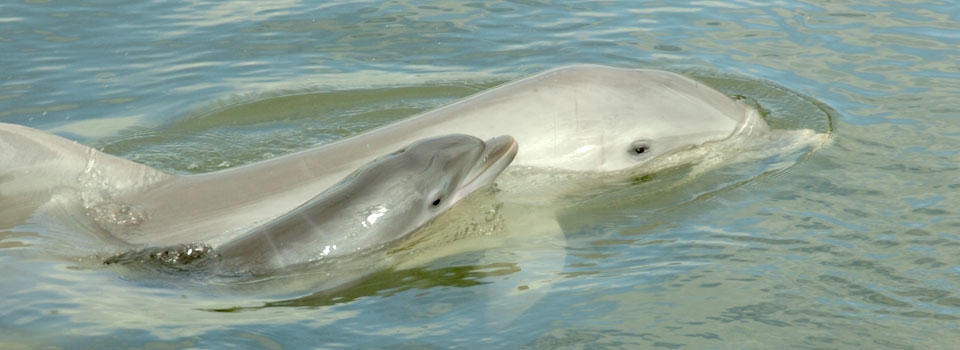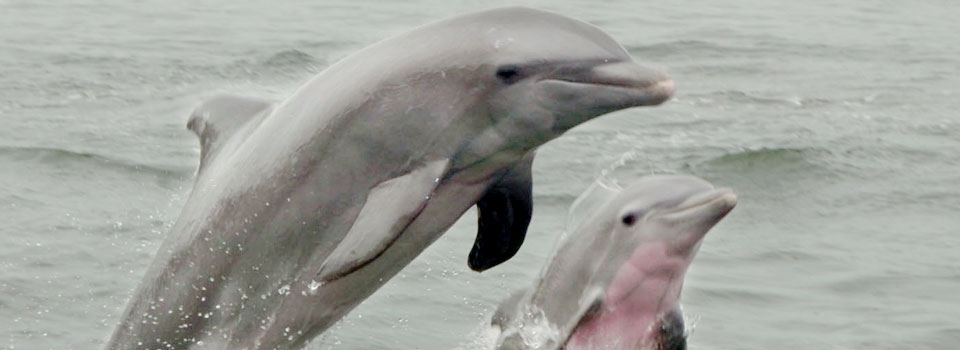Dolphin Maternity
Humans have been breeding common bottlenose dolphins in human care for decades. The knowledge gained from this activity has been invaluable for scientists around the world. Understanding the reproductive and maternity cycles of dolphins and whales not only broadens our knowledge base, but also provides essential information when dealing with stranded juvenile cetaceans as well as the potential re-population of endangered species.
Breeding in Human Care
During the mid 1980s, peers within the marine mammal care industry instituted a voluntary agreement to refrain from taking any more common bottlenose dolphins from the wild. Part of the reasoning behind such an agreement was due to how well common bottlenose dolphins breed in human care.
Dolphin Research Center has been trying to breed dolphins since its foundation. Because not all of the dolphins at DRC are breeding dolphins (due to age & health), we must be very careful about genetic ties. Some marine mammal facilities participate in loaning programs to facilitate genetic diversity within their breeding programs. DRC does not partake in this activity, as we presently have no need. We have a diverse enough breeding population. (We would also miss them if they left—they are our family!)
Gender Differences
Dolphins have no secondary sex characteristics. The only way to determine a dolphin’s gender in the wild is to see a clear view of their genitals, or to observe an erection, act of intercourse, or a baby swimming close to an adult presumed to be a female.
Males have two slits that look similar to an exclamation point. The long anterior slit houses the genitals, while the smaller posterior slit houses the anus. Two small pores are present on either side of the genital-anal slit, which have been considered possible vestigial nipples.
Females have one continuous slit which houses both the anal and genital openings, the anus located towards the posterior. Females also have a set of slits housing the mammary glands. These slits flank either side of the genital slit. Occasionally females will have extra false sets of mammary slits. These extra slits are generally non-functional and could be a hold over from the dolphin’s terrestrial ancestor.
Amorous Activities
There is no actual mating season for dolphins. They mate 365 days a year. Ninety percent of their mating activity, however, is foreplay. Intercourse only takes seconds. Males become sexually mature between 8 to 12 years of age. Females become sexually mature a little sooner at around 5 to 10 years of age (Wells 1999).
Much of the amorous activity between dolphins includes chasing each other around and raking each other with their teeth. Dolphins have a tendency to get lazy looking eyes and lie on their sides, sinking like a log, when they feel amorous. The more dominant dolphin is usually found beneath the more passive dolphin, which often stays on the surface and resembles a “floating log”.
Dolphins are indiscriminately amorous. They have sex with the opposite gender, the same gender, and engage in masturbation with inanimate objects. Female dolphins have been observed suctioning things (like plates) to their genital region when they feel amorous. They also seem to enjoy buzzing on each others' slits using echolocation (Samuels 1989).
What are the possible reasons for this type of behavior as it is not just procreational? It is believed that dolphins may engage in this type of behavior to learn about sex as well as to maintain strong social bonds for many sorts of cooperative activities (Nguyen 1999).
Male Reproductive Tract
Dolphins must maintain a streamlined body to move efficiently through the ocean. Therefore, male dolphins have their penis and testicles packed inside their body. On mammals, testicles are usually found outside the body since sperm dies at body temperature. Dolphins compensate for the extra heat that their testicles must endure by utilizing a special feature of their circulatory system. A network of blood vessels goes from the testicles to the dorsal fin and flukes, drawing heat away from the sperm/testicles, returning with cooled blood which then surrounds the testicles and keeps them below the dolphin’s core body temperature ( Harrison 1948). This same network of blood vessels surrounds a female dolphin’s uterus, also keeping the fetus below the dolphin’s core body temperature.
Male dolphins are also designed to have quick erections. They do not require stimulus (foreplay) to become erect, unlike humans. Ejaculation seems to be under voluntary control. In fact, some of DRC’s dolphins have been trained to ejaculate on signal. Mating must occur quickly in the wild, so this is advantageous to a male dolphin. Imagine if you were in the middle of mating and a bull shark appeared. You would certainly want to be able to finish spreading your genes and get out of the area in a hurry!
Female Reproductive Tract
Female dolphins have a bicornate uterus, meaning they have two internal reproductive horns that each act as uteri ( Harrison 1969). It is thought to be a possible evolutionary link to their land ancestors. Their uterine system is similar to a horse or cow.
Each female dolphin tends to use either the right or left ovary. There is some indication that they switch the ovary/uterus they are using later in life. Female dolphins are thought to be “spontaneous” ovulators and don’t necessarily have a set cycle. The cervix itself is also unique. It has annular folds (or pseudocervix) seen in only cetaceans and manatees. There is also a mucous plug between the folds and actual cervix. Depositing and storing sperm here protects it from the salt water, which would kill sperm instantaneously (Robeck 1948).
The fold of the pseudocervix contains some muscle bundles and appears capable of some movement. Perhaps the retraction of the penis triggers muscular contractions of the pseudocervix, thereby shutting out lethal seawater and assisting in the sperm’s movement through the mucous plug to the true cervix (Boyd 1999).
Seasonality
Dolphin births can occur any month of the year. There do seem to be peaks in Florida, however, in the spring and in the fall. How can we tell if a female is ovulating? By tracking when a calf was born and figuring approximately a year earlier, we can estimate when the female ovulated. DRC can also detect follicular growth on the ovary by using an ultrasound machine on female dolphins. Female dolphins typically ovulate from 2-7 times a year (Dierauf & Gulland, 2001), with a cycle varying in length typically around 21-42 days (Robeck et al 2004, Schroeder 1990, Kirby & Ridgway, 1984). This seems to be a highly individualized process. Through blood sampling we have seen that some females at DRC have ovulated six times a year and others once a year, and some even skip a year. Females can ovulate without males around, but male company seems to sometimes stimulate a female’s ovulation cycle.
Pregnancy
Recent research indicates that bottlenose dolphin pregnancy lasts about 12 months (Wells 1987). During this time, there is very little room in the uterus for a baby to develop. As a result, and to make birth easier, the tail fluke and dorsal are cartilaginous and are folded over in the uterus. The organs are also located beneath the developing baby, which could be the reason for a female gaining more girth during pregnancy and not developing a bulge (Cockroft 1990).
Mothers double their intake of food following the birth of their babies. Intervals between calves vary from about three to five years.
Social Groupings
We take blood tests and urine samples to analyze hormone levels. High progesterone levels can indicate if a female is pregnant. If a dolphin’s progesterone levels indicate a possible pregnancy we then perform an ultrasound. An ultrasound allows us to “see” into the dolphin’s belly, confirm a pregnancy and estimate how far along the mother is in the process.
This knowledge gives us the opportunity to place the mom in a good birthing situation. When a female has been confirmed to be pregnant, we ensure that she is in a positive birthing environment, which includes a protected lagoon and compatible female pool mates that have some birthing experience. Males are not present during or after a birth at Dolphin Research Center, as they can present a danger to a small calf.
Groupings of females with calves occur naturally in the wild. The groupings are called maternity pods (Wells 1999). DRC tries to emulate these natural formations. It is important to have other females available to a mother dolphin. Female dolphins have been seen assisting in birth, and more consistently as baby-sitters or aunties helping to rear young dolphins. One of the best ways a female dolphin can learn how to care for a calf is to be around a baby and other more experienced females.
Once a calf is born, DRC continues to watch the relationship between the females. We also conduct observational studies to learn more about the entire maternity process.
Adult male dolphins generally do not appear around females unless mating. Male dolphins tend to congregate in groups of two or three and sometimes form what is known as a “pair bond”. Pair bonded males will stay together for an extended period, if not all of their lives. Male dolphins play no role in raising their young. In fact, male dolphins have been known to be a threat to baby dolphins (Wells 1999).
Adolescent dolphins also congregate in separate groupings called juvenile pods. This will occur once a calf is old enough to leave its mother (Wells 1999).
Mothering Style
Each female dolphin seems to have a unique mothering style. Some mothers are very protective parents, while others seem more relaxed with letting their calves explore. These variations have also been observed in the wild.
Babies
Babies are usually born tail first, weigh 25-40lbs, and are generally three to four feet long (Wells 1999). We can get an approximate idea of how old a baby is by looking at the dorsal fin. It is thought that the dorsal fin stiffens within a few hours. The tail flukes seem to take a bit longer.
A baby dolphin swims in a position next to its mother called the echelon position. The baby swims in this position to catch mom’s slipstream, allowing the calf to work less hard in order to keep up with its mother.
When babies are born they have lighter colored bands spanning their mid section. These are called fetal bands and are caused from being scrunched up in the mother’s womb. These bands will slough off after multiple weeks.
Newborn dolphins are very dark in color. It is possible that this dark shading is used for camouflage as the baby travels in the mother’s shadow. This coloration also sloughs off after multiple weeks.
When we assess the health of a newborn, we look for good body weight and good breathing. Another way we can get a good indication of the baby’s health is from the mother’s behavior. If she is relaxed and comfortable, it is a good sign. If a baby is not healthy, a mother will usually display frantic and erratic behavior.
When babies are new to the world, they have to get used to their bodies not only swimming, but also breathing. They have to get comfortable with their blowhole’s location. As a result, babies do something called chin slap breathing, which involves lifting their heads farther out of the water than necessary to breathe.
Echolocation is an ability that babies learn how to use over time. For this reason babies end up with a few cuts and scrapes within the first weeks of life.
Due to the need to look out for a clumsy calf, you sometimes see mothers “steering” their calves away from what might be considered a danger. Merina had a lot of steering to do within her daughter Pandora’s first very active days of life. Pandora was quite spirited and would often try and race in front of her mother. We often saw Merina physically pick Pandora up with her rostrum and place her in another part of the pool.
Nursing
Babies nurse an average of about every twenty minutes or more for 24 hours a day. In the first few weeks of life this can happen in more frequent intervals. They nurse, on average, a minimum of two years, but have been observed nursing up to four and a half years (Wells 1999).
Calves have many fringes along the edges of their tongue, believed to be an aid in nursing. Calves apparently roll their tongue and clasp the fringes together in order to form a watertight funnel for the milk to flow through. Mothers take the active role in nursing by squirting the milk into the baby’s mouth. The milk is very high in fat and contains colostrum. Colostrum provides antibodies that help protect the calf against infection during those critical first months of life.
Watching the maternity aspect of a dolphin’s life is an amazing experience. The knowledge that we can gain by studying this facet of cetacean life can provide valuable insights into the life of a dolphin.
References:
Boyd, I., Lockyear, and Marsh. “Reproduction in Marine Mammals.”218-286. In J. E. Reynolds III and S. A Rommel, eds, Biology of Marine Mammals. Washington, DC: Smithsonian Institution Press, 1999.
Cockroft and Ross. Observations on the Early Development of a Captive Bottlenose Dolphin Calf. The Bottlenose Dolphin. Chapter 27, 1990.
Harrison , R. Reproduction and Reproductive Organs. The Biology of Marine Mammals. Academic Press, New York, New York, 1969. pp 253–348.
Nguyen, D. and Mann. “Sociosexual Development in Bottlenose Dolphin Calves,” Proceedings of the Seventh Annual Atlantic Coastal Dolphin Conference, Virginia Beach, Va., March 19-21, 1999. p 11.
Robeck et al. “Reproductive Biology of the Bottlenose Dolphin (Tursiops truncatus) and the Potential Application of Advanced Reproductive Technologies.” Journal of Zoo and Wildlife Medicine. 25, no. 3, 1994. pp 321-36
Samuels, A. et al. “Gentle Rubbing Among Bottlenose Dolphins.” Proceedings of the Eighth Biennial Conference on the Biology of Marine Mammals, Pacific Grove, CA, December 1989. p 58.
Wells and Scott. “Bottlenose Dolphin Tursiops truncatus Montagu, 1821,” 137-82. In S. Ridgeway and R. Harrison, eds., Handbook of Marine Mammals. Vol. 6, The Second Book of Dolphins and Porpoises. New York: Academic Press, 1999.
Wells et al. “The Social Structure of Free-Ranging Bottlenose Dolphins,” 247-305. In H.G. Genoway’s, ed., Current Mammalogy. Vol. 1. New York: Plenum Press, 1987.














